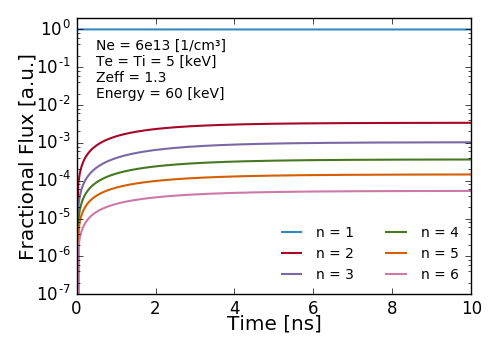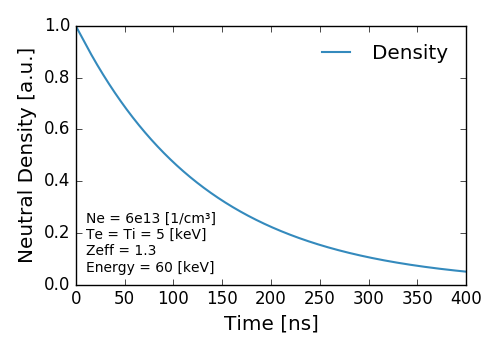Collisional Radiative Model
Collisional Radiative Model
The collisions that a neutral particle experiences as it travels through a plasma changes the distribution of its energy level population. The types of collisions that FIDASIM takes into account is as follows
- Spontaneous decay:
- Electron-impact excitation/de-excitation:
- Ion-impact excitation/de-excitation:
- Impurity-impact excitation/de-excitation:
- Electron-impact ionization:
- Ion-impact ionization:
- Impurity-impact ionization:
- Charge exchange with ions:
- Charge exchange with impurities:
The above rate coefficients have units of and are calculated by averaging the respective collisional cross sections with a Maxwellian of the relevent species. The population of the energy level of a neutral atom, , can be described by the following time dependent differential equation where the are the respective target densities.
By rearranging the terms and letting represent excitation/de-excitation depending on the order of the indices we can get the following equation where and
The system of differential equations can be compactly represented as a matrix multiplication.
The solution of this matrix differential equation takes the form of a matrix exponential
where is a vector of the neutral population flux [1/s] for each energy state at time , is the matrix of the eigenvectors of and is a diagonal matrix containing the eigenvalues of . The fractional flux of a neutral traveling through a uniform plasma is shown below.

As you can see the relative populations between states converges fairly quickly.
The number of neutrals in a given state after a time , , is given by
If represents the time spent inside a grid cell the neutral density can be calculated by dividing the above equation by . The total neutral density of a mc marker is shown below.

As you can see over time the total number of neutrals decreases exponentially.
Fortran References
- colrad: Fortran implementation
- get_rate_matrix: Constructs rate matrix
- AtomicRates: Derived type that stores populating and de-populating transitions